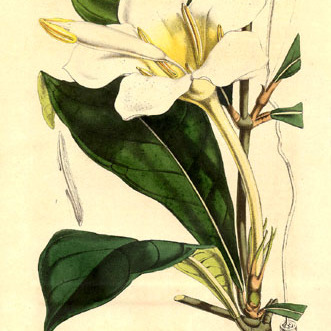Corolla white, golden pubescent outside when dry; tube narrowly cylindrical below, funnel-shaped above, 5.3–23 cm long, the funnel-shaped portion 2–7.8 cm long and 2.6–8.2 cm wide at the top, the cylindrical part 4–8 mm wide, glabrous or pubescent within the funnel-shaped portion, pubescent within the cylindrical portion; lobes 1.6–6.8 × 1.6–5.8(8) cm, ovate, acute or rounded, creamish tomentose above, overlapping to the left in bud.
A shrub. It grows 4-9 m tall. The leaves are dark green above and dull underneath. They appear in groups of 3 from the same node. The leaves are oval and 30 cm long. Flowers open at night and have a slight scent. The fruit are green and have lobes. They are 5 cm wide. They are rusty brown when young.
Leaf blades (9)10–29 × 3.5–13 cm, elliptic to obovate, acuminate at apex, cuneate at base, coriaceous, glabrous above, pubescent to ± glabrous beneath; domatia absent; petioles 7–21 mm long, puberulous or glabrescent; stipules triangular, acuminate, 2–6 mm long, pubescent, deciduous.
Calyx golden-or reddish-brown pubescent; tube 10-grooved when dry, 6–13 mm long; limb-tube 7–23 mm long, wider than the tube; lobes linear, 0.9–5(8) × 0.15–0.4 cm, ± equal.
Fruit 2.8–7 cm in diameter, globose, smooth or strongly 10-ribbed, rusty pubescent when young, ± glabrous later on, crowned by the persistent calyx limb.
Flowers sweet-scented, solitary, pendent; peduncle 5–25 mm long, reddish pubescent, bearing 2–6 acute triangular bracteoles 2.5–3 mm long.
Pollen presenter large, 3–7.5 × 0.6–1.1 cm, distinctly bilobed at apex, wholly or partly exserted.
Flowers fragrant with the corolla white inside brownish-velvety outside, pendulous
Shrub or small tree 1.8–8.5(15) m tall; young stems pubescent.
Fruit 10-ridged or nearly smooth, yielding an inky black dye
Seeds c. 0.7–1.1 cm long, c. 3–4 mm thick, ± sublenticular.
Anthers included or with tips exserted, 2.7–4.5 cm long.
Style 7.5–18.5 cm long, abruptly widened at the top.
A shrub or tree, 6-40 ft. high


